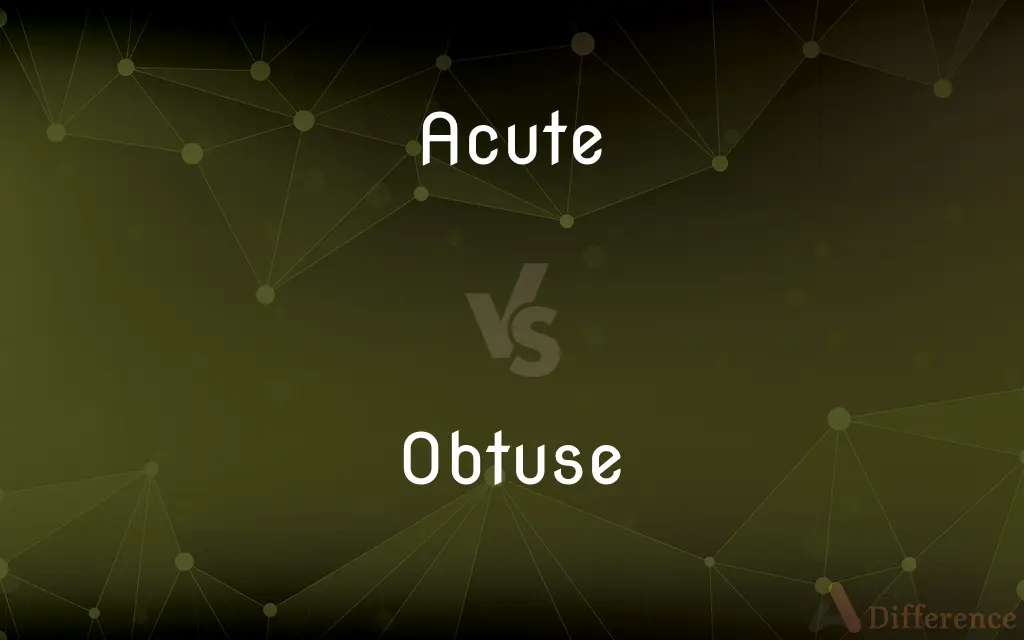Acute vs. Obtuse — What's the Difference?
By Tayyaba Rehman & Maham Liaqat — Updated on March 19, 2024
Acute angles are less than 90 degrees, highlighting sharpness and precision, while obtuse angles exceed 90 degrees, embodying broadness and openness.

Difference Between Acute and Obtuse
Table of Contents
ADVERTISEMENT
Key Differences
Acute angles are defined by their sharpness, measuring less than 90 degrees, making them appear pointed and precise. This quality is often associated with precision in geometry, whereas obtuse angles, measuring more than 90 degrees, appear wider and less sharp, evoking a sense of openness and expansiveness. This difference in measurement reflects not only their appearance but also their application in various geometric contexts.
In terms of visualization, acute angles can be seen as creating a tight, narrow point, often used in the design of objects that require precision, such as the tip of a knife. On the other hand, obtuse angles, with their wide opening, are reminiscent of more open spaces and can be seen in designs that require a broader perspective, like the angle between the wings of an open book.
From a mathematical perspective, acute angles are integral to constructing various geometric figures, especially those emphasizing tightness and compactness, whereas obtuse angles play a crucial role in shapes and figures that require a wider scope, adding diversity to geometric designs and concepts.
In practical applications, acute angles are commonly found in tools and objects that require effective cutting or piercing capabilities, reflecting their sharpness and efficiency. Meanwhile, obtuse angles are often observed in architecture and furniture design, where a gentle, wide angle can contribute to the aesthetics and functionality of the space.
Acute angles and obtuse angles also differ in their symbolic meanings. Acute angles are often associated with precision, alertness, and speed, reminiscent of the acute senses of an animal, while obtuse angles might symbolize stability, openness, and relaxation, reflecting a more laid-back or broad approach.
ADVERTISEMENT
Comparison Chart
Degree Measurement
Less than 90 degrees
More than 90 degrees
Visual Appearance
Sharp, pointed
Wide, less sharp
Geometric Application
Used in precise, tight configurations
Used in broad, expansive configurations
Practical Use
Found in cutting tools, objects requiring precision
Common in architecture, wide-angle designs
Symbolic Meaning
Precision, alertness, speed
Stability, openness, relaxation
Compare with Definitions
Acute
Highly perceptive or discerning.
Her acute observations made her an excellent critic.
Obtuse
Slow to understand or perceive.
His obtuse understanding of the rules frustrated the team.
Acute
Characterized by sharpness or severity.
An acute sense of smell can detect subtle fragrances.
Obtuse
Lacking sharpness or quickness of sensibility.
An obtuse response to the urgent news surprised everyone.
Acute
Extremely serious or severe.
An acute shortage of water can lead to drought conditions.
Obtuse
Not sharp or pointed; blunt.
The discussion was hindered by his obtuse comments.
Acute
Having a sudden onset and short course.
Acute illnesses often require immediate attention.
Obtuse
Difficult to understand; not clear.
The poet's obtuse references require careful interpretation.
Acute
A sharp angle measuring less than 90 degrees.
The acute angle between the clock's hands at 10:00 is striking.
Obtuse
An angle that is broad, measuring more than 90 degrees.
The obtuse angle in the park's layout creates a welcoming space.
Acute
(of an unpleasant or unwelcome situation or phenomenon) present or experienced to a severe or intense degree
An acute housing shortage
The problem is acute and getting worse
Obtuse
Annoyingly insensitive or slow to understand
He wondered if the doctor was being deliberately obtuse
Acute
Having or showing a perceptive understanding or insight; shrewd
An acute awareness of changing fashions
Obtuse
(of an angle) more than 90° and less than 180°
An obtuse angle of 150°
Acute
(of an angle) less than 90°.
Obtuse
Not sharp-pointed or sharp-edged; blunt
It had strange obtuse teeth
Acute
(of a sound) high; shrill.
Obtuse
Lacking quickness of perception or intellect.
Acute
Short for acute accent
Obtuse
Characterized by a lack of intelligence or sensitivity
An obtuse remark.
Acute
Reacting readily to stimuli or impressions; sensitive
His hearing was unusually acute.
Obtuse
Not distinctly felt
An obtuse pain.
Acute
Keenly perceptive or discerning
An acute critic of music.
A critic with acute judgment.
Obtuse
Not sharp, pointed, or acute in form; blunt.
Acute
Extremely sharp or severe; intense
Acute pain.
Acute pleasure.
Obtuse
Having an obtuse angle
An obtuse triangle.
Acute
Of great importance or consequence; critical
An acute shortage of funds.
Obtuse
(Botany) Having a blunt or rounded tip
An obtuse leaf.
Acute
Having a rapid onset and following a short but severe course
An acute disease.
Obtuse
; not sharp, pointed, or acute in form.
Acute
Afflicted by a disease exhibiting a rapid onset followed by a short, severe course
Acute patients.
Obtuse
Blunt, or rounded at the extremity.
Acute
High in pitch; shrill
An acute scream.
Obtuse
Larger than one, and smaller than two right angles, or more than 90° and less than 180°.
Acute
Narrowly pointed; sharp
An acute leaf.
Obtuse
, having an obtuse angle.
Acute
Having an acute angle
An acute triangle.
Obtuse
Intellectually dull or dim-witted.
Acute
Brief, quick, short.
It was an acute event.
Obtuse
Indirect or circuitous.
Acute
High or shrill.
An acute accent or tone
Obtuse
To dull or reduce an emotion or a physical state.
Acute
Intense, sensitive, sharp.
She had an acute sense of honour
Eagles have very acute vision.
Obtuse
Not pointed or acute; blunt; - applied esp. to angles greater than a right angle, or containing more than ninety degrees.
Acute
Urgent.
His need for medical attention was acute.
Obtuse
Not having acute sensibility or perceptions; not alert, especially to the feelings of others; dull; stupid; as, obtuse senses.
Acute
(botany) With the sides meeting directly to form an acute angle (at an apex or base).
Obtuse
Of an angle; between 90 and 180 degrees
Acute
Less than 90 degrees.
The teacher pointed out the acute angle.
Obtuse
Of a leaf shape; rounded at the apex
Acute
Having all three interior angles measuring less than 90 degrees.
An acute triangle
Obtuse
Lacking in insight or discernment;
Too obtuse to grasp the implications of his behavior
A purblind oligarchy that flatly refused to see that history was condemning it to the dustbin
Acute
Of an accent or tone: generally higher than others.
Obtuse
Slow to learn or understand; lacking intellectual acuity;
So dense he never understands anything I say to him
Never met anyone quite so dim
Although dull at classical learning, at mathematics he was uncommonly quick
Dumb officials make some really dumb decisions
He was either normally stupid or being deliberately obtuse
Worked with the slow students
Acute
Sharp, produced in the front of the mouth. (See Grave and acute)
Acute
(medicine) Of a short-lived condition, in contrast to a chronic condition; this sense also does not imply severity.
The acute symptoms resolved promptly.
Acute
(orthography) After a letter of the alphabet: having an acute accent.
The last letter of ‘café’ is ‘e’ acute.
Acute
(medicine) A person who has the acute form of a disorder, such as schizophrenia.
Acute
An accent or tone higher than others.
Acute
(orthography) An acute accent (´).
The word ‘cafe’ often has an acute over the ‘e’.
Acute
To give an acute sound to.
He acutes his rising inflection too much.
Acute
To make acute; to sharpen, to whet.
Acute
Sharp at the end; ending in a sharp point; pointed; - opposed to blunt or obtuse; as, an acute angle; an acute leaf.
Acute
Having nice discernment; perceiving or using minute distinctions; penetrating; clever; shrewd; - opposed to dull or stupid; as, an acute observer; acute remarks, or reasoning.
Acute
Having nice or quick sensibility; susceptible to slight impressions; acting keenly on the senses; sharp; keen; intense; as, a man of acute eyesight, hearing, or feeling; acute pain or pleasure.
Acute
High, or shrill, in respect to some other sound; - opposed to grave or low; as, an acute tone or accent.
Acute
Attended with symptoms of some degree of severity, and coming speedily to a crisis; - opposed to chronic; as, an acute disease.
Acute
To give an acute sound to; as, he acutes his rising inflection too much.
Acute
A mark (') placed above a vowel to indicate pronunciation
Acute
Having or experiencing a rapid onset and short but severe course;
Acute appendicitis
The acute phase of the illness
Acute patients
Acute
Extremely sharp or intense;
Acute pain
Felt acute annoyance
Intense itching and burning
Acute
Having or demonstrating ability to recognize or draw fine distinctions;
An acute observer of politics and politicians
Incisive comments
Icy knifelike reasoning
As sharp and incisive as the stroke of a fang
Penetrating insight
Frequent penetrative observations
Acute
Of an angle; less than 90 degrees
Acute
Ending in a sharp point
Acute
Of critical importance and consequence;
An acute (or critical) lack of research funds
Common Curiosities
What defines an acute angle?
An acute angle is any angle measuring less than 90 degrees.
Can a triangle have more than one obtuse angle?
No, a triangle can only have one obtuse angle because the angles in a triangle must sum to 180 degrees.
How is an obtuse angle defined?
An obtuse angle is one that measures more than 90 degrees but less than 180 degrees.
Are all angles either acute or obtuse?
No, angles that measure exactly 90 degrees are called right angles, and angles over 180 degrees are called reflex angles.
How do acute angles contribute to geometry?
Acute angles contribute to creating tight, precise geometric figures and designs.
Is a 90-degree angle considered acute or obtuse?
A 90-degree angle is neither acute nor obtuse; it is a right angle.
Do acute angles only occur in geometry?
While commonly discussed in geometry, acute angles are also significant in physics, art, and design.
How do acute and obtuse angles appear in real life?
Acute angles appear in sharp, precise tools, while obtuse angles are seen in architecture and broad designs.
Can an angle be both acute and obtuse?
No, an angle cannot be both acute and obtuse; these categories are mutually exclusive.
What is the range of degrees for an obtuse angle?
An obtuse angle ranges from more than 90 degrees to less than 180 degrees.
What role do obtuse angles play in design?
Obtuse angles contribute to broader, more open designs in architecture and layout.
Can acute angles be found in nature?
Yes, acute angles are common in nature, such as in the shapes of leaves and the angles of branches.
Are obtuse angles less common than acute angles?
Not necessarily; obtuse angles are as common as acute angles, especially in man-made structures and natural formations.
How does one measure an obtuse angle?
An obtuse angle can be measured with a protractor, just like any other angle.
What practical uses do obtuse angles have?
Obtuse angles are used in various designs, including architecture, furniture, and urban planning, for aesthetic and functional purposes.
Share Your Discovery

Previous Comparison
Rendering vs. Rending
Next Comparison
Dale vs. ValeAuthor Spotlight
Written by
Tayyaba RehmanTayyaba Rehman is a distinguished writer, currently serving as a primary contributor to askdifference.com. As a researcher in semantics and etymology, Tayyaba's passion for the complexity of languages and their distinctions has found a perfect home on the platform. Tayyaba delves into the intricacies of language, distinguishing between commonly confused words and phrases, thereby providing clarity for readers worldwide.
Co-written by
Maham Liaqat












































